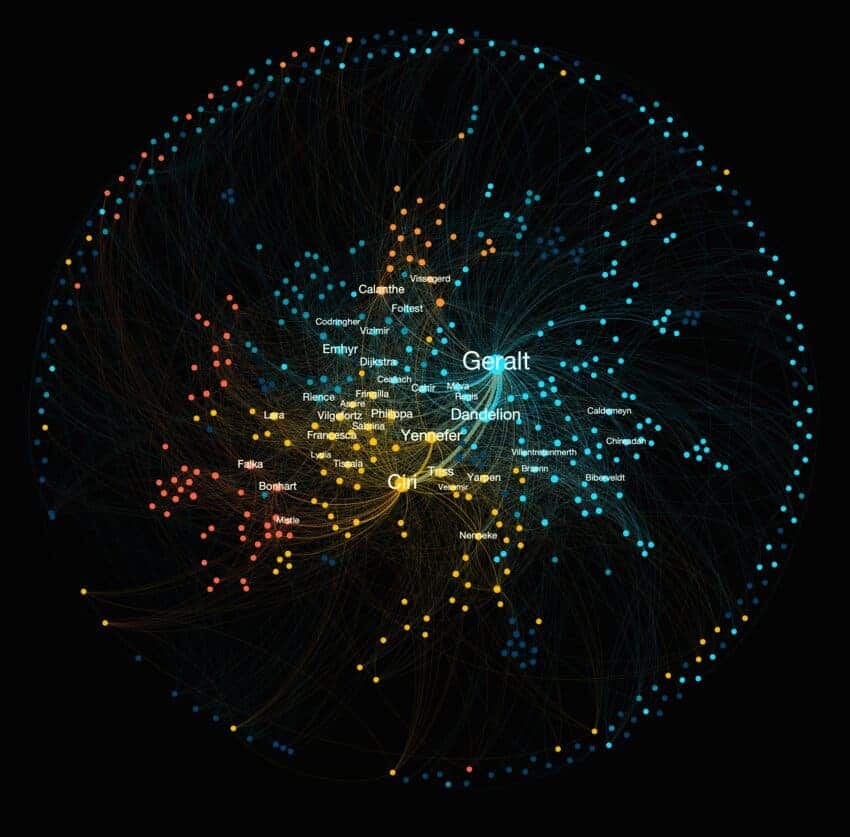A stunning new graphical display shows how characters in The Witcher intertwine throughout the plot.
Andrej Sapkowski’s The Witcher series of books, one which is a favorite among the ZME Science team as well, has become increasingly popular and well-known over the last few years. Several videogames and a Netflix series based on the books definitely helped in this regard. Testament to its popularity is that the latest season of the show was watched for a worldwide total of 2.2 billion minutes in its debut week alone.

Milán Janosov, lead scientist at Datopolis with a Ph.D. in Network Science from Central European University is obviously also a fan of the series. He has recently put together a visual representation of the relationships between the characters of this universe using the magic of network science. In a paper he published on the work, Janosov details the process of creating this representation.
Steel for men, network science for plots
“I started reading “‘The Witcher’ early last year, shortly after I got hooked to the Netflix show, and the storyline just sucked me in,” Janosov told Ingrid Fadelli at TechXplore. “It was a somewhat similar experience to watching ‘Game of Thrones’ a few years ago, which had also inspired one of my research articles. When I was about to finish watching the new season of Witcher, I started to wonder how I could get more out of this.”
His first step was to collect the data needed to create the visualization. Janosov started with the subtitles of the Netflix adaptation of the books, but quickly realized they would not do by themselves, and ended up drawing on the books as well.
“To build a network, I also needed a complete list of the characters who appeared in the series,” Janosov said. “After collecting these initial pieces of information, my job was fairly simple. I wrote a computer program that screened through every single sentence of all the books and took a note every time it matched a character’s name into a sentence.”
The program noted each point where a character’s name would appear. From this, it calculated how close or far apart two characters were, based on how often they were mentioned together and at what interval. For example, whether they were mentioned in the same sentence or two apart. The program tracked these mentions up to five sentences away, which Janosov says is a “pretty good indicator” of whether two characters have actually met or were featured in the same plots”.
In the final visualization, the characters of the narrative are represented as nodes, with the main 50 characters being labeled by name. The size of each mode signifies how central they are to the story, and different colors represent different communities, which not all characters share. The number of links formed between nodes is based on how often two characters were mentioned within a five-sentence span of each other in the novel.
“While context is relatively easy to interpret for humans, for a computer, it is not that simple,” Janosov explained. “So to capture the context of the characters mentioned, I assumed that two characters were mentioned in the same context as they were not mentioned further than five sentences from each other. While the number five is somewhat arbitrary, it was chosen for the sake of simplicity (and OCD-friendliness), because three, four or even six sentence-distances lead to very similar results too, also staying consistent for example with the typical paragraph lengths in written text.”
This paper is an example of how network science can use datasets to spot hidden patterns in unstructured data. While any reader would get a general idea of the relationships in the novels after reading The Witcher series, Janosov’s visualization lays them down in easily-seen detail.
“In our daily lives, we are surrounded by social networks: our friends on social media, our colleagues at work, friends from school, family, sports and hobbies, and many more,” Janosov said. “All these social systems are intertwined by networks of which we almost always only have a partial and subjective understanding. To overcome this lack of knowledge and sparsity of information, network science comes really handy as it provides a set of tools and a framework of thinking that can help us better understand these social networks we participate in daily, just as it helped to clear the fog around ‘The Witcher.'”
Janosov adds that the research could be useful, as similar approaches are already being used, in real-world settings. International trade and communications are a great example of where network science can be brought to bear to uncover hidden trends.
For now, however, it allows us all to enjoy this wonderful illustration and gives fans a great way to immerse themselves further in the universe of The Witcher.
The paper “A Network Map of The Witcher” has been published in the pre-print server arXiv.


